Scotland is an amazing destination renowned for many things: castles, golf, kilts, haggis and it’s amazing scenery. Scotland is also promoted as an adventure destination. However, there are thousands of people who visit Scotland every year but have no idea of the opportunities they can experience. Your experience is greatly enhanced if you invest a wee bit in expert guidance. Many people list our scenery as one of the motivating factors for a visit to Scotland. It also ranks highly as one of the reasons to go hiking.
Choosing a holiday destination is not always easy. There are a lot of considerations which come in to play. How much time do you have available? How much money do you have available? Do you have a short list to choose from? What images are influencing you? And these days, of course, you have your friends images and reviews to peruse via social media. If you’re a keen hiker, you probably already know, that Scotland has amazing scenery. Maybe you’re putting Scotland on your short list. In our experience running accommodation and adventure holidays in Scotland, it’s still got untapped potential and a lot of advantages as an adventure destination which most people don’t know about.
Waiting for the cloud to clear to reveal the spectacular view which can’t be seen from the road.
Photo credit: Scot Mountain Holidays
Photo description: A guided hiking vacation in the Cairngorms, Scotland – off the beaten track thanks to our excellent, world-beating access legislation.
Everyone has a right of responsible access in Scotland due to The Outdoor Access. You are legally allowed to walk/bike/canoe anywhere they wish. You do need to avoid the immediate grounds of a building. So you don’t have the right to walk across someone’s manicured garden. You do have the right to roam the hills at will without sticking to what few paths there are.
Do be careful when out on the high ground though because there is not a system of well-maintained way marked paths across the hills, unlike other European countries. In fact, if you have not been out hiking in Scotland before it would be advisable to book a local guide for the first time you go out. You will have a more in-depth appreciation for the countryside you’re walking through with your guide.
The guide would have extensive knowledge of:
which you as a visitor would never be able to glean during your short visit to the area without his/her presence.
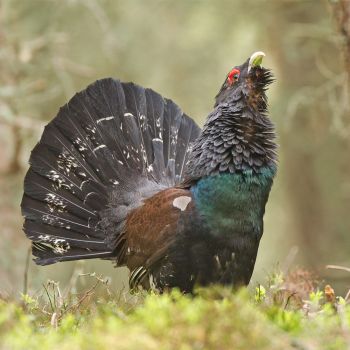
Photo credit: Jamie MacArthur (www.ornithography.com)
Photo description: A Capercaillie in the Cairngorms
Scotland has celebrated the Year of Natural (2013) and the Year of Adventure (2012). The Golden Eagle was voted Scotland’s most iconic species. The attraction of the wildlife is a growing sector of tourism in Scotland, particularly to the Highlands and Islands. You could expect to see red squirrels, red deer, reindeer, roe deer, eagles, otters and a multitude of other animals throughout the Highlands. Most of these iconic animals are frequently found in the Cairngorms. The Cairngorms feature heavily in all the BBC Spring, Autumn and Winter Watch programmes. However, you don’t need to worry about bear or wolf attacks. There are no large animal predators in the wild. Camping is a relatively safe experience; the main concern being a biting fly known as the midge (which will not trouble you on a windy day and is only around in the main summer months).
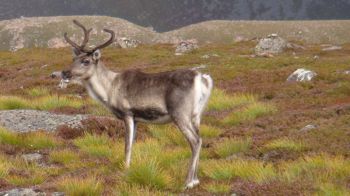
Photo credit: Scot Mountain Holidays
Photo description: Part of the Cairngorm Reindeer Herd which roam free in the hills during the summer months.
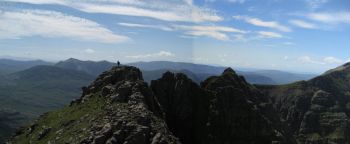
Photo credit: David Webster
Photo description: Ridge walking on Liathach, Torridon, Highlands of Scotland with Scot Mountain Holidays
Scotland has ancient mountain scenery full of mystique and history, which draws thousands of tourists every year. Most visitors only experience the views from the road. There are plenty of views to be seen from the roadside, but the best of the landscape can only be experienced by immersing yourself. Exploring the Highlands without a car has its trials but hiking, canoeing, adventure biking etc here in the Highlands is the way to go.
The beauty of Scotland speaks for itself in many images and has formed inspiration for movies and art worldwide:
There are several long distance paths which are waymarked across Scotland, but the high hills are not waymarked. There are paths which crisscross the high mountains but a knowledge of map reading and compass work are necessary to deal with the changeable weather conditions and wild scenery.
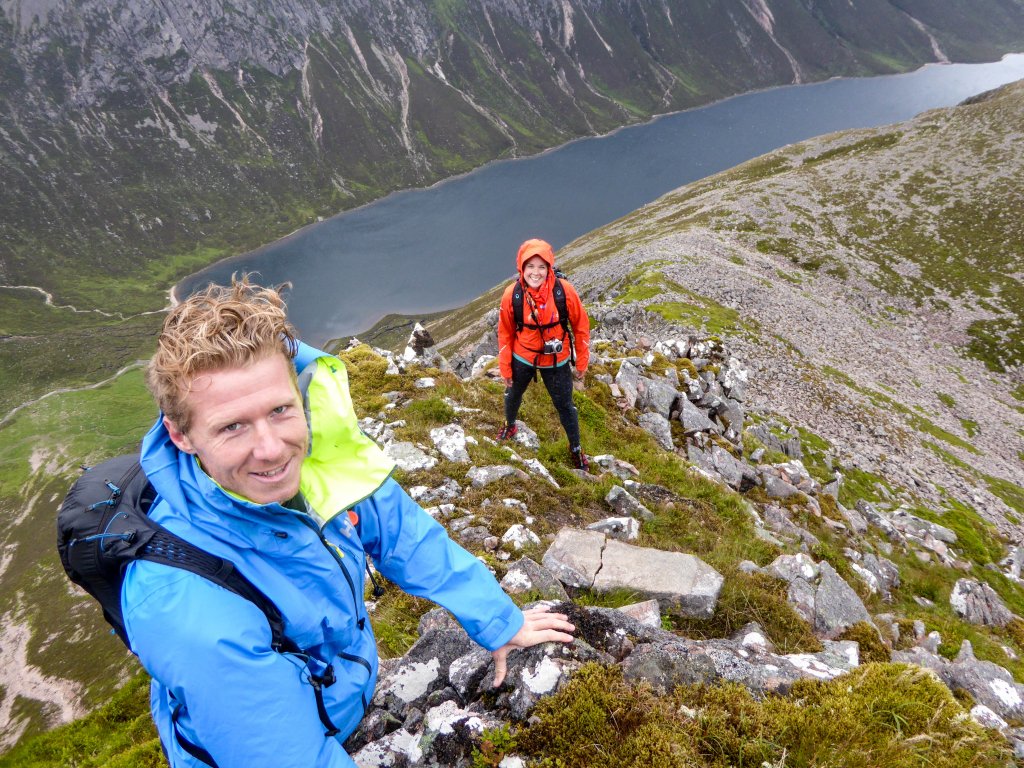
Happy snaps mid climb
Photo description: Viewpoint obove Loch Aan in the Cairngorms showing the cliffs by shelter stone. Some of the stunning features of the Cairngorms which can’t be seen from the road.
Scotland’s highest peak is Ben Nevis at 1,344m. To many Europeans this seems merely a bump, but when you consider that the route up the mountain starts at sea level, it becomes a decent mountain day. Most people take about 8 hours to complete the route up and down Ben Nevis, even by the regular “tourist” route; but for all that it is not an 8000m peak it should still not be under-estimated.
The changeable weather conditions, our maritime climate, in the UK make an ascent of any of the hills challenging, except in the most stable of weather conditions. People do die in our mountains every year. You don’t need to worry about altitude sickness or having to carry oxygen to summit the mountain and most summits can be reached without any need for ropes. All risks in the mountains can be limited by employing a guide with the relevant training and experience.
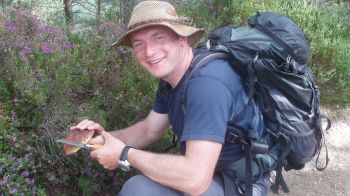
There are international flights to Scotland through Edinburgh and Glasgow with onward flights or good public connections through bus and train onwards to the Highlands. However, to make the most of your time in the Highlands your best transport option is still either to hire a car or to book a suitable tour with a guiding company which will take in the routes at the top of your list or allow them to pick to routes best suited to your ambitions, taking account of the prevailing weather and terrain conditions.
You can reach most of the hills in Scotland on a day walk, within the capabilities of most hikers. There are more extensive routes – which take several days to complete, but you can reach the summit of most individual peaks in a day.
If you do choose to undertake any of the long distance routes you will find that with the exception of the West Highland Way and possibly the Great Glen Way, you are unlikely to see many other people during your walk. So far, Scotland is accessible without being crowded.
The following companies are expert at arranging walking tours and hiking holidays of various kinds:
Hiking is the ideal way to explore the Scottish Highlands
Visit Scotland’s walking information
WalkHighlands: A comprehensive resource for any independent hikers planning to visit Scotland:
Check out the Lairig Ghru mention in the top list of walks in Scotland
Ramblers info about walking in Scotland
12 Trail rules you should know
8 of the best long distance hikes in Scotland
With the Easter holiday almost upon us, it’s time to plan some exciting day trips which might be an option if you are based at Fraoch Lodge, in the Cairngorms. From exploring the legendary Loch Ness to indulging in whisky tasting on a Speyside whisky tour, there’s no shortage of adventures waiting to be had. Let’s dive into some exhilarating options for your Easter getaway:
Embark on a thrilling adventure to Loch Ness, famed for its mythical monster. While public transport is an option, self-driving offers more flexibility. Consider booking a boat tour with Jacobite Cruises to explore the depths of the loch and catch a glimpse of Urquhart Castle. Don’t miss out on off-the-beaten-track gems like Loch Ness Clayworks or a hike up Meall Fuar-mhonaidh for breathtaking views.
So long as you don’t decide to do the “grockle” tour all the way around Loch Ness, you should still have time to tag on a Dolphin Tour with Dolphin Spirit in Inverness.
Indulge in Scotland’s liquid gold with a tour of Speyside’s renowned whisky distilleries. Immerse yourself in the rich history and craftsmanship behind Scotland’s national drink as you sample a variety of single malts. With distilleries like Glenfiddich and Glenlivet dotting the landscape, you’re in for a treat. We highly recommend Glenfarclas distillery if you like the more personal touch from a smaller, more family oriented distillery.
NB Some distillery tours can be pretty expensive now but if you’re looking for something a wee bit more special then the whisky and chocolate pairing which is a speciality of Dalwhinnie distillery is worth trying (but more out of the way than the other Speyside distilleries and will possibly form part of a different tour or a wet day option.
TOP TIP: make sure you have time for a visit/tour of the Speyside Cooperage at Craigellachie, just outside Aberlour. It is fascinating the see the coopers at work refurbishing and creating the casks essential for the whisky industry.
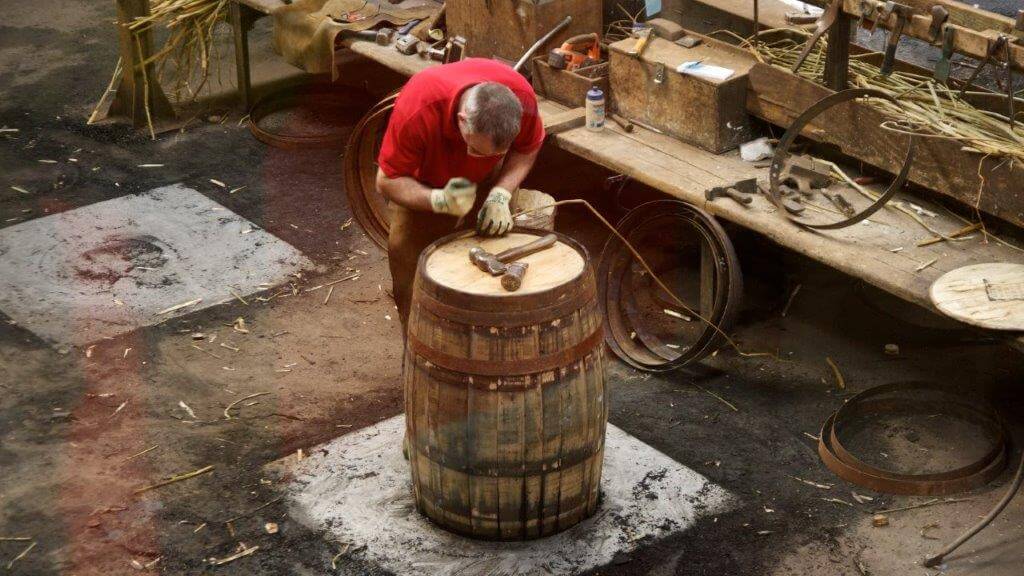
A cooper hard at work repairing casks at the Speyside Cooperage
Get up close and personal with Scotland’s native wildlife at the Highland Wildlife Park. From red deer to Scottish wildcats, the park offers a unique opportunity to observe these majestic creatures in their natural habitat. Spring is a great time to visit the park as you’re in with a very high chance of seeing the baby animals. The park often has newborn additions around this time.
On your way back you could also call in at Leault farm to check out the sheep dog trials. The skill and agility of sheepdogs in action at the sheepdog trials is an experience not to be missed. Kids are also sometimes invited to help out with a bit of sheep shearing and to handle the puppies, if you’re lucky enough to be there when there are pups.

Meeting the puppies after the sheepdog demonstrations here in the Cairngorms National Park
For adrenaline junkies, head on mountain bikes to the zip trek park for an action-packed day of thrills. Zoom through the treetops on exhilarating zip lines or tackle challenging mountain bike trails amidst stunning scenery. Whether you’re a seasoned pro or a novice adventurer, there’s something for everyone here.
Explore the Cairngorms on foot with a scenic mountain hike or choose a more gentle stroll along the glen; round a loch; or through a forest. Choose from a variety of trails catering to all skill levels, from gentle strolls to challenging ascents. Be sure to pack a picnic and take in the breathtaking vistas along the way. Your hosts at Fraoch Lodge, Andy and Rebecca, thoroughly enjoy exploring the are on foot (and by bike); so much so that it is part of their sister business. Andy is a fully qualified mountain leader with more than 20 years experience in the Cairngorms National Park. He’s the one to ask if you’re looking for the best hiking experience possible. You can even book him as a guide if you’re keen to see more; learn more and explore as much as possible.
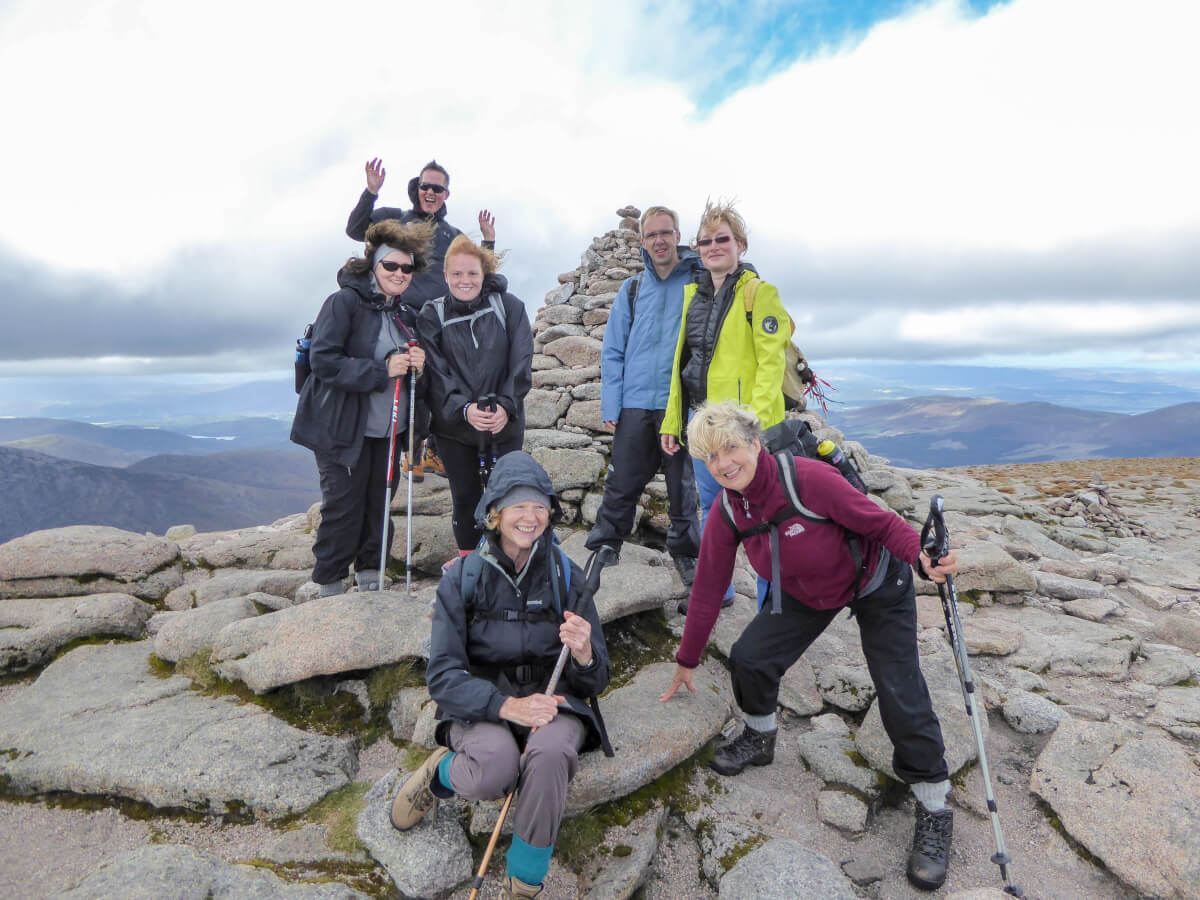
Hiking group celebrate reaching the top of one of Scotland’s many mountains
Take to the waters of Loch Insh for a tranquil canoeing experience. Paddle along the serene waters surrounded by stunning Highland scenery, keeping an eye out for local wildlife along the shoreline.
Venture further afield to explore the historic town of Fort William and nearby Glenfinnan. Marvel at the towering peak of Ben Nevis, the highest mountain in the British Isles, and visit the iconic Glenfinnan Viaduct, made famous by the Harry Potter films.
With so many lochs around, not to mention the river Spey as well, wild swimming is certainly an option to consider (if that’s you thing). Since lockdown the number of people enjoying a “dook” has exploded and htere are now full on holiday options where you can explore several different swim spots (under guidance/with a group). If you’d like to plan/check the options available there are now guidebooks available which will also let you know of any potential hazards.
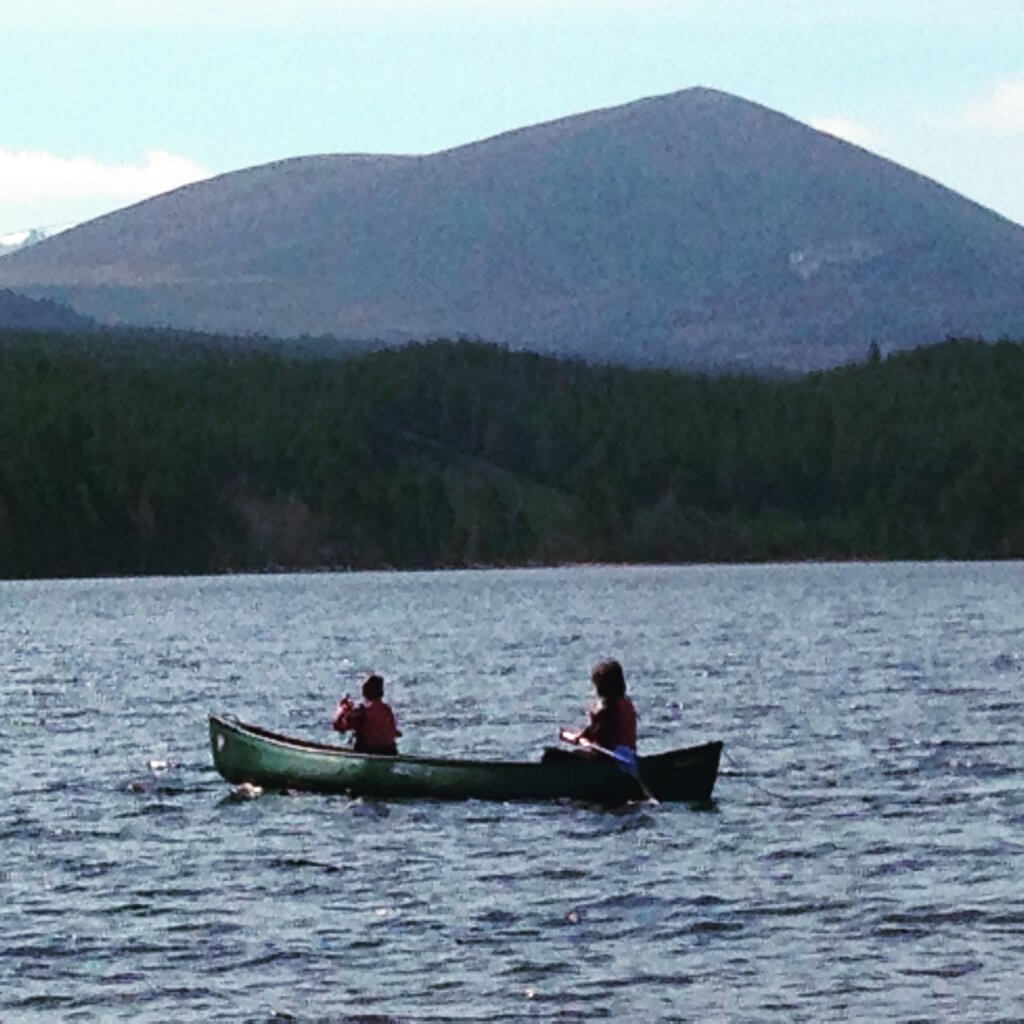
Canoeing on Loch Morlich in the Cairngorms
If the weather takes a turn, there are plenty of indoor activities to enjoy. Head to The Ledge Climbing Centre in Inverness for some indoor rock climbing fun, or embark on a distillery tour to sample Scotland’s finest whiskies. For a relaxing day, unwind at the Aquadome and soak in the warm waters of the indoor pool.
Head up in the direction of Elgin and work your way back along the coast to Forres or Inverness. At Elgin you can check out the ruins of the cathedral; the Johnsons of Elgin factory and tour; Elchies goat farm; and don’t miss out on Duffes castle which is a ruin but well worth exploring. The coast along here round Hopeman, Cummingston and Burghead is well worth exploring for the rock formations alone, let alone the bouldering and climbing opportunities. This is all part of the longer hiking path: the Moray Coastal Trail.
Work your way along the coast to Findhorn beach where we recommend you stop for ice cream or a pint/meal.
Top tip: try the seafood chowder at the Kimberley Inn
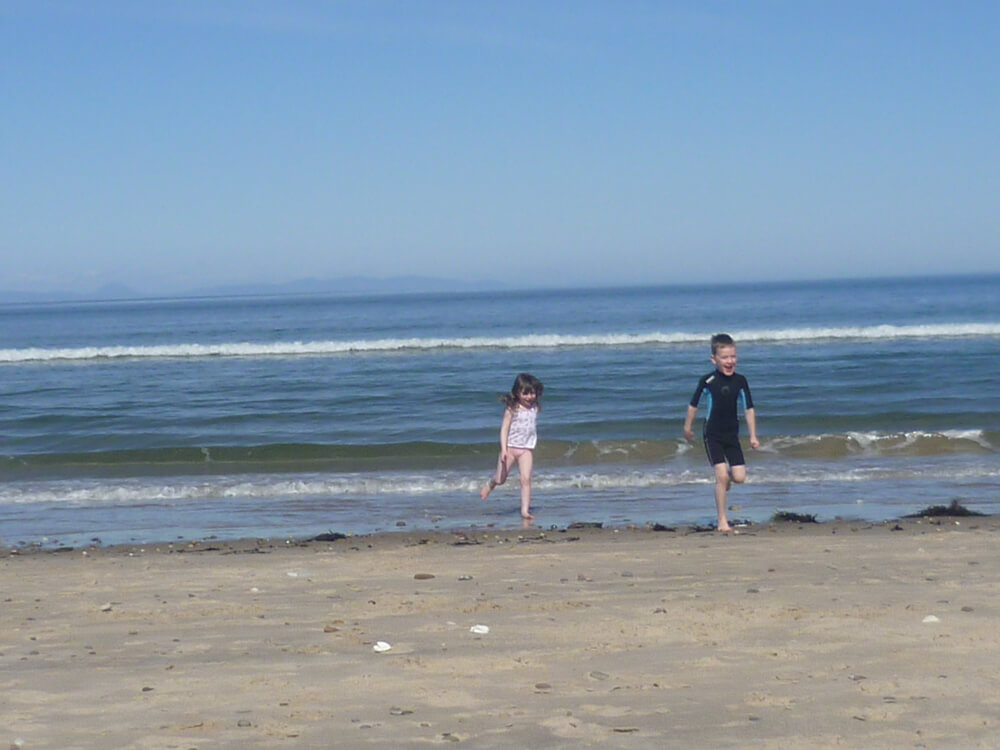
Playing on the beach at Findhorn.
With so much to see and do, your Easter getaway in the Cairngorms is sure to be an unforgettable adventure. Whether you’re seeking outdoor thrills or cultural experiences, there’s something for everyone to enjoy in this stunning corner of Scotland.
So many people have heard of the isle of Skye, and millions have watched the movies set there. Everyone wants to go and experience the beauty of Skye for themselves. What they forget is that everyone else has now heard about Skye too. There are the down sides … rain, midges, crowds … but it still has a reputation to beat most other places in the Highlands, except perhaps Loch Ness.
Skye is blessed by being mentioned in music, in movies and in history. It has a distillery, castles, stunning jagged mountains and is eminently accessible now there is a bridge. Is it still an island if it is connected to the mainland by a bridge?
The isle of Skye now has iconic status and has made it on to the “must see” bucket list of so many when they plan their visit to Scotland. Unfortunately many just take a day or 2 on a bus tour. If you can, really try to get under the surface and spend a wee bit more time exploring to find those hidden gems most people whizz past.
Social media seems to have concentrated the effect of tourists travelling to Skye. You can’t get away from tour minibuses if you’re going to visit all those spots you’ve seen on social media: the Old Man of Storr or the Fairy Pools or the Quirang, unless of course you’re going to go at antisocial times. However, Skye is a very large island and if you’re prepared to divert from the popular hotspots and get away from the road, then you’ll probably be able to find your own peaceful viewpoint – but it will take a little more effort than a 20 minute walk.
The spots most people have heard of will be the busiest. One of the reasons many people have heard of them is that they are accessible. Unfortunately the accessibility generates it’s own issues and if you are driving on the isle of Skye you need to watch out not only for sheep on the road, but also for parking opportunities and take care with motor homes. The roads are not designed for wide vehicles. Be very careful to make sure you are not blocking any access and your car is well off the road if at all possible even if it means you might need to walk a wee bit further to get the best photo.
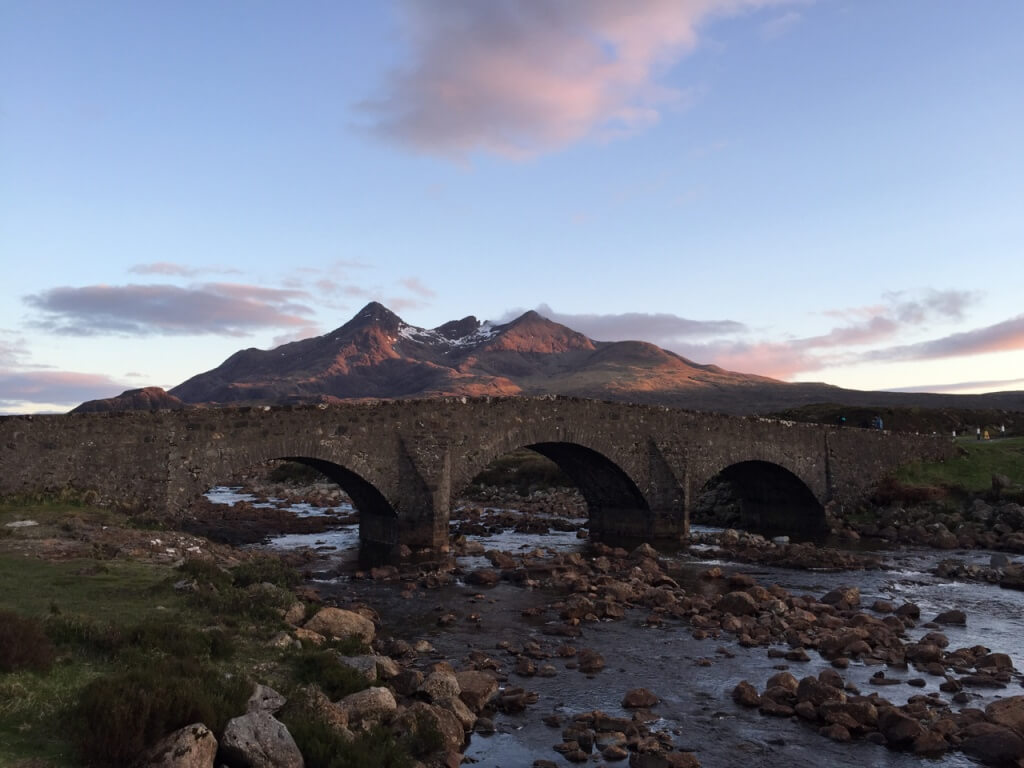
Sunset over Am Basteir from Sligachan on the Isle of Skye during the Skye Munros itinerary
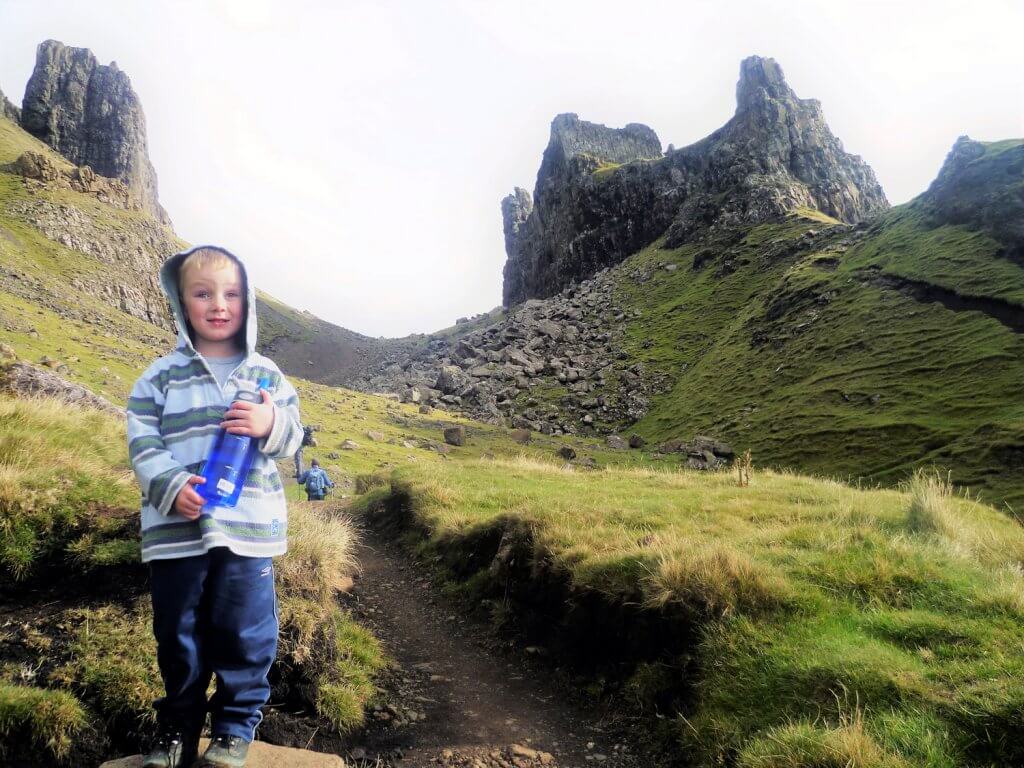
Visiting the Quirang on the Isle of Skye. Easily accessible for most, except wheelchair users.
Not unique to Skye but there are many on the island. However, there is also a herd at Rothiemurchus, near Aviemore (Cairngorms National Park) and near Grantown on Spey on the Revack Estate.
Clearly visible from the road and from Portree on a good day, the Old Man of Storr is a most photogenic rock formation. You can certainly understand why so many make the short walk up to it. It is on the minibus circuit so even on a bad weather day in the main season, starting in May, it can be difficult to find a space in the car park unless you get out early or arrive late. To be honest, unless you can get away from the other tourists, you may not fully appreciate the site anyway at there is nothing like the presence of other people to destroy a peaceful atmosphere, which could affect your memories.
Not so popular with most self-drive tourists due to the more serious nature of the walks. Still there are always people stopping by the Sligachan Hotel to take photos. Up close, they are even more stunning but a guide would be advised if you are intending to head into the high Cuillin as the peaks are quite sheer climbs and require some scrambling or in some cases roped climbing.
If you’re really keen to get up into the mountains, maybe bag the munros, you could join us for either the Skye Munros or our less scary version (ie without the roped climbing) – Skye Cuillin for hillwalkers
Did you know that dinosaurs once walked on Skye? Perhaps one of the lesser known tourist sites on Skye but still popular enough to make the cafe nearby pretty busy.
All these movies have featured shots of some iconic sites on the isle of Skye
The BFG, Macbeth, Stardust, The Land That Time Forgot, Snow White and the Huntsman, 47 Ronin, King Arthur: Legend of the Sword, and Transformers: The Last Knight, The Ridge, Highlander, Made of Honour, Breaking the Waves
Movie map of the Highlands and Skye
Lots of traffic on small roads – be careful driving round Skye, particularly if you have a camper van. Some roads are pretty narrow, or even single track and there are a lot of minibus tours driving round the island.
Lack of accommodation – it is almost compulsory to pre-book in the height of the summer season now.
Midges – the west coast of Scotland is mecca for midges, particularly on a damp, still day
Rain – check out the rain map of Scotland. The further east you go; the less rain you’ll find. However, when the weather is fine, Skye is magical.
North West Scotland is one of the best kept secrets we have had here in the Highlands. While flocks of tourists have visited the isle of Skye, not nearly so many have made the pilgrimage north. This is changing now with the advent of the “North Coast 500”.
It’s interesting isn’t it, what can be done by packaging something in marketing terms. There has always been a road around the north coast of Scotland. The road has always been there. Someone had a great marketing idea and renamed the road as the “North Coast 500” and introduced it to the general public as a must-see driving tour to rival Route 66 in the US. They have done an amazing job and now more and more people are driving up round the north of Scotland. New companies and tour experiences are popping up all over the place. If you do go up, more than likely you’ll meet either a convoy of Lamborginis or a convoy of motorhomes!

The spectacular sandstone peaks of Torridon, over 2500 million years old
This is one of our favourite areas of north west Scotland. Personally we think it is more stunning than the isle of Skye and certainly has hiking to rival the isle of Skye. We take groups over to Torridon nearly every year using a variety of large holiday cottages and getting to know the area well. There’s a small community there so much so that we are recognised in the gallery now.
If you do go to Torridon, be sure to pre-book your accommodation and any places you’d like to eat out as there are a limited number of places to go and also a very limited number of places to top up your supplies. It’s a great area for galleries and crafts with many artists taking their inspiration from the surrounding landscape. If you’d like to explore the Torridon area in depth, you should join us for our Classic Torridon itinerary.
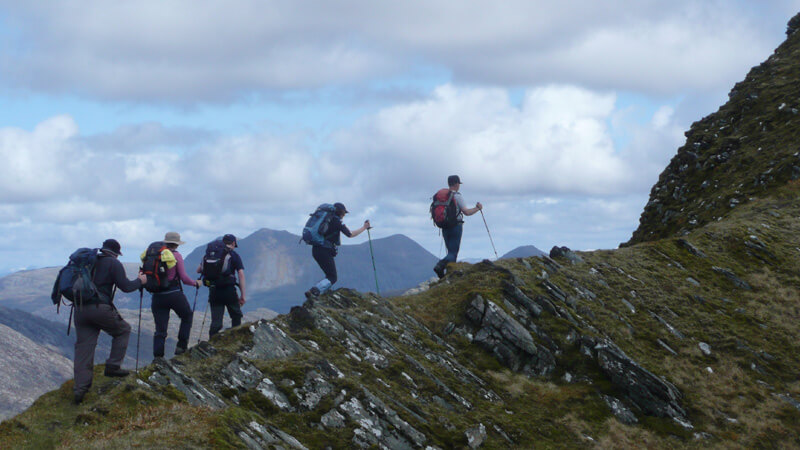
The ridges of the Knoydart peaks
Another favourite area of ours but only really appreciated by those who are looking to get away from mainstream living or those who love to hike. Knoydart is only accessible by boat or by a long walk-in. Wifi has reached the area so you don’t need to be completely without access to the outside world, but don’t expect to get a strong phone signal.
Knoydart is more remote than Skye but just as beautiful. There are plenty of opportunities to see wildlife as there are far fewer people around and there is a gorgeous beach which is right next to the main campsite. The beach is a definite plus – something which Skye lacks mostly.
We’re heading over to Knoydart again in September so if you have a week to spare at the beginning of September, do come and join us.
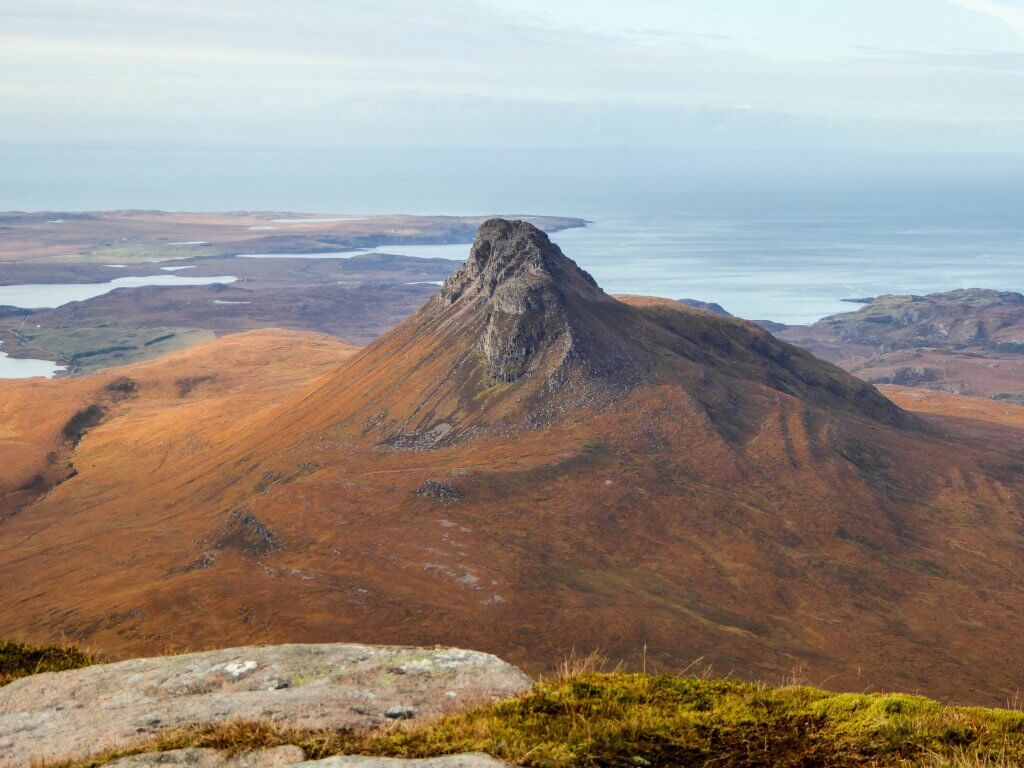
Stac Pollaidh, Assynt, Scotland – north of Inverness
Needless to say we love Assynt and choose to take personal breaks here if our free moments coincide with good weather over there. Our Empty Quarter itinerary makes the most of the most spectacular walking in the area. As with all our trips, you need to take time to slow down and appreciate this area rather than rushing from place to place to fill up your camera with the same shots as everyone else.
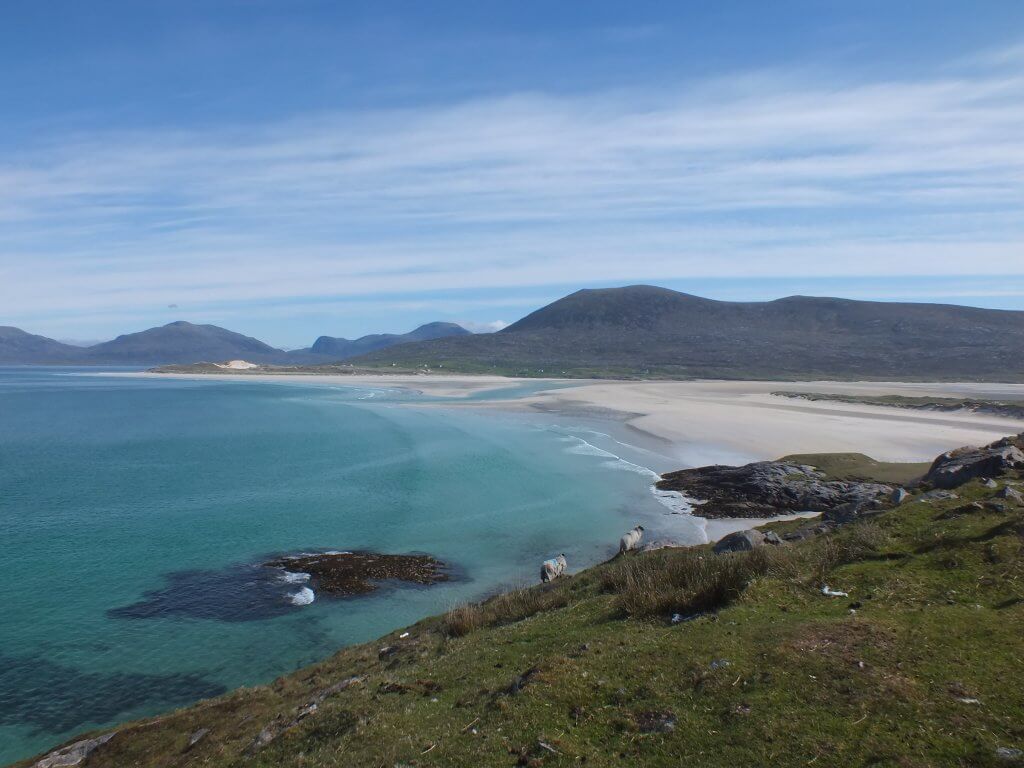
Beautiful beaches at Seilbost and Luskentyre on Harris in the Outer Hebrides
The Outer Hebrides are famous for their beaches. You need to look a little harder to find the hiking, but it is glorious wild country not much explored by others. The islands can absorb a lot of visitors particularly if you can get away from the roads. If you follow the coffin road across Harris, you’re unlikely to see many people at all until you look down on the sandy stretches of Luskentyre. Should you be there at low tide, you’ll probably find a long stretch of empty sand pretty much to yourself.
If you like hiking, you’ll love the Western Isles Wilderness itinerary we’re running at the end of September. Looking forward to some glorious light and photo opportunities.
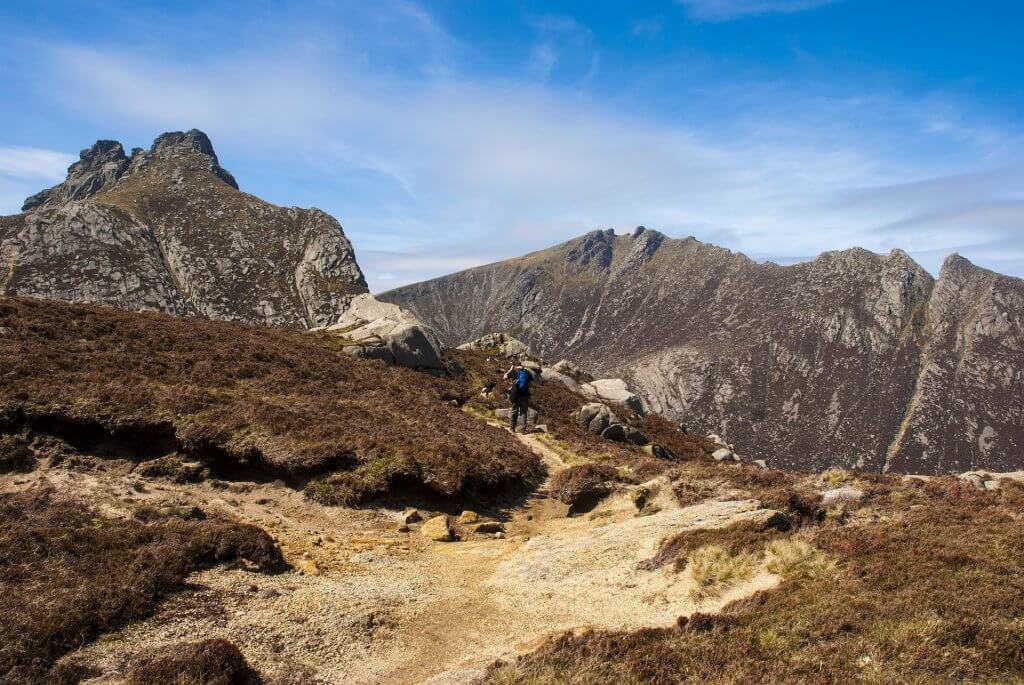
We often talk about Arran being Scotland in miniature. It is very much true. Arran has mountains, beaches, castles and amazing fresh produce. It is relatively accessible from Glasgow, but really you can easily spend a week on the island without being bored.
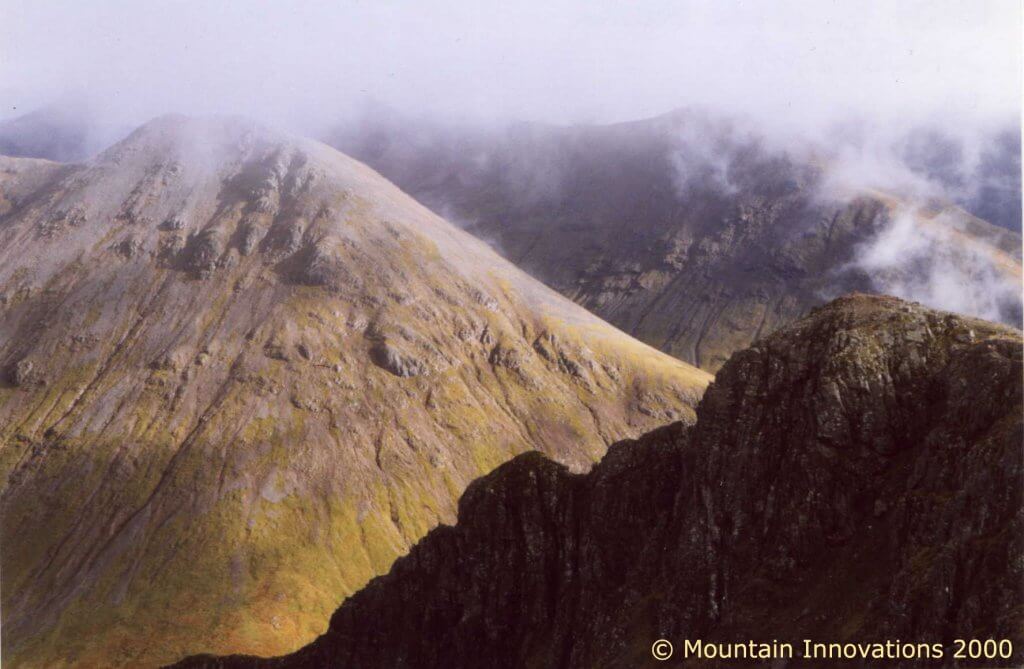
The dramatic hills of Glencoe
Do you really need to say more than just “Glencoe“? The scenery is very dramatic. You can appreciate it from the road, but there are even more fabulous sites to be seen if you are able to hike up into the peaks which line the road. Summer programme will be forthcoming 2019 or 2020.
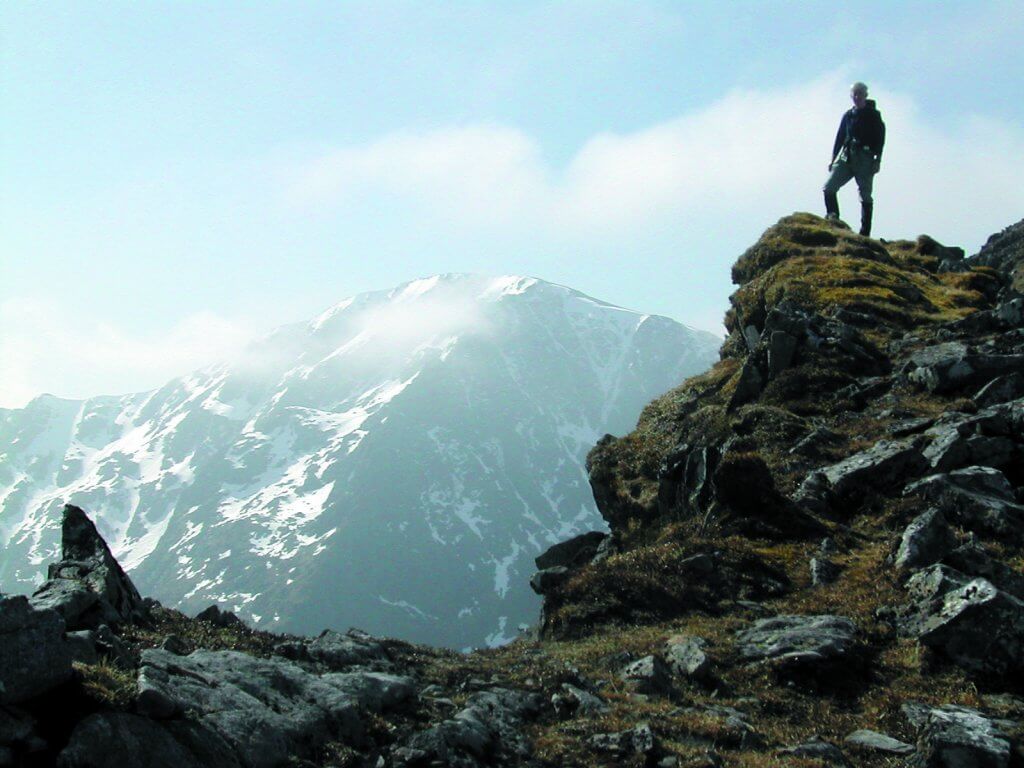
Atop the Aonach Eagach ridge in Glencoe
Planning a summer trip to Scotland and want to go to the Isle of Skye? Make sure you pre-book and resign yourself to being in company if you want to visit the popular sites. All is not lost though as there are ways to avoid the crowds. Personally we like to head out and find our own space, so we tend to keep our visits to Skye out of the main season, which fortunately also means away from the midges and most of the campervan!
How exciting! The approach of the school Easter holidays is always an exciting time here in the Highlands of Scotland, especially in Boat of Garten, as it signifies the start of so many more opportunities to get out and about. Winter can be a bit of a sleepy time, when if you don’t ski, there are far fewer places to go and things to do than during the summer. Many of the castles and other visitor attractions either close or are on such reduced opening hours, you wonder why they bother at all. But once we’re over half way through March, we can look forward to being spoilt for choice

The ospreys should be returning to Boat of Garten in April. The RSPB are poised to open up the visitor centre over the Easter holidays and are closely monitoring the birds on their migration back to Scotland. Unfortunately sometimes the chicks get lost over in Africa, but hopefully our current pair will make it back safely. It’s been a bit of a soap opera down at Loch Garten in recent seasons so who knows what’s in store this year.
The centre itself has been through quite a revamp though so we now have webcams to see the white tailed (sea) eagle’s nest and a goshawk nest as well as the Ospreys.
Your Natural Adventure in the Cairngorms
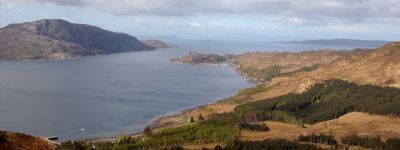
Photo Caption: Wild and remote scenery of Knoydart on a visit in May – Wild Knoydart guided walking holiday
If we think about hiking in Spring, the long daylight hours definitely make it more pleasurable – if challenging to get the kids to sleep when camping. At the beginning of March, we already have 10.5 hours of daylight here in the Cairngorms but by the end of March it’s already increased rapidly and we’re up to 13 hours daylight. For example, March 19th 2015 sunrise is around 6.20am and sunset about 6.25pm. Early starts no longer essential to make the most of the daylight.
Scottish sunrises and sunsets – images from Scot Mountain Holidays
Sunrise and sunset times in the Cairngorms
Don’t kid yourself – it’s hard to keep fit in winter. Even if it’s not snowing, the shorter days and cooler temperatures just bring to mind more images of hibernating than getting outside and hiking or biking.
Of course, there are those (in a large minority) who love winter for the snow, for the skiing etc; but for the rest of us it takes a cattleprod to get out to the gym … but then something magical happens by the middle or February as the days start to lengthen here in the Highlands and all of a sudden it’s not so hard to get up and out. There is certainly a reason why we have the phrase: “The Joys of Spring”. Now we can say goodbye to the inside of a sweaty gym and take the bike out of the shed, dust off the backpack and take the running shoes out in the woods and along the trails.
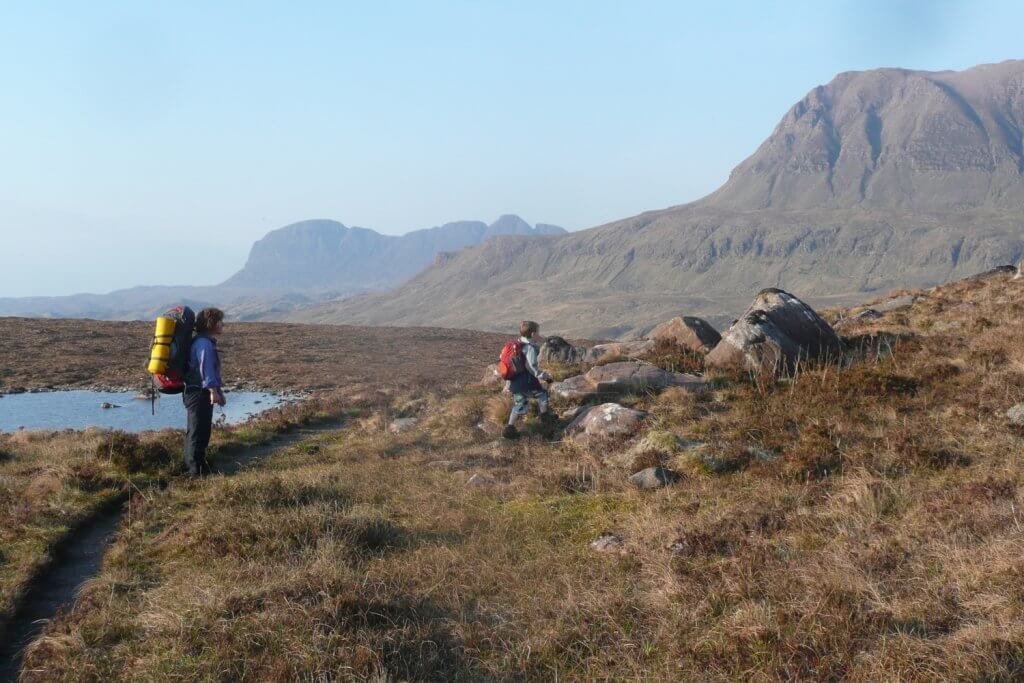
Hiking in to a secret wild camping spot in Assynt
Photo caption: Spring also means that it’s a time the kids can get back outside. You no longer need to wrap them up like Mummies. This photo was taken on a backpack to a wild camp in Assynt in May. If you’d like details of this trip, we can arrange this for small groups and family groups under Andy’s guidance.
In winter, we spend a lot of time instructing about the dangers involved in going out on the snow and ice. Andy runs multiple courses showing clients how to use ice axe and crampons and how to assess the risk of avalanches. All these are things which put the multitude of hikers off. Most people perceive the Highlands as being far too dangerous in winter. You’d almost be taking your life in your own hands to even consider it. Of course, reality is nothing like that and for the number of people who do go out in the hills. The number who have accidents or need to call on mountain rescue is a minute proportion. Accidents are always reported in the media which exaggerates the frequency with which they occur.
Nevertheless, Spring means that these worries can retreat once more and the hiking boots can be dusted off and the maps taken down once more to plan for some high level hikes across the hills. There’s a reason why events such as the TGO Challenge take place in the Spring.
Do bear in mind though – that winter is never far away in Spring here in the mountains and due to our latitude, snow can return with unexpected force in April and May.
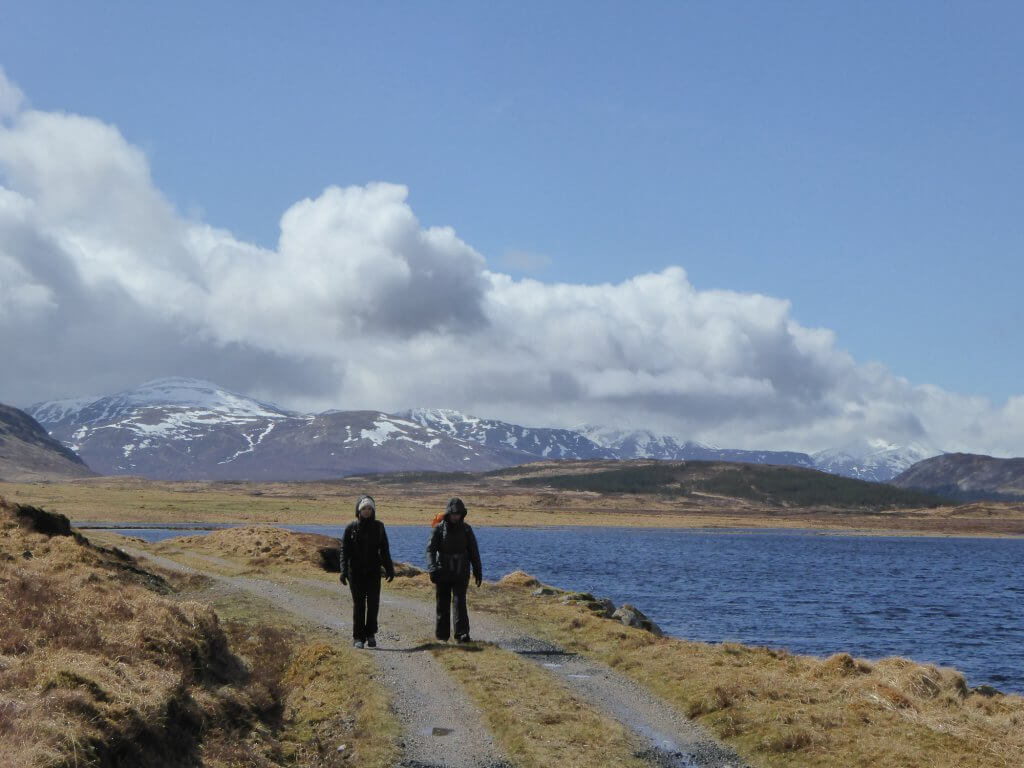
Perfect spring weather for hiking
Hiking in Spring means that you can enjoy long blue sky days, without the ever-present midge. To be honest, in the Cairngorms the midge question is not as great a threat as on the west coast. Despite the relative proximity of the west coast (in Australian or American terms) the weather is very different. In the Cairngorms, the weather is drier and the winters on average colder. Cold winters greatly reduce the presence of midges in the summer.
You can tell our local climatic zone is drier more often than the west coat by the colour of our hills. The hills in the Cairngorms in summer are purple as the bell heather flowers. Bell heather likes dry conditions to flourish. The wetter west coast hills are generally green and grass covered.
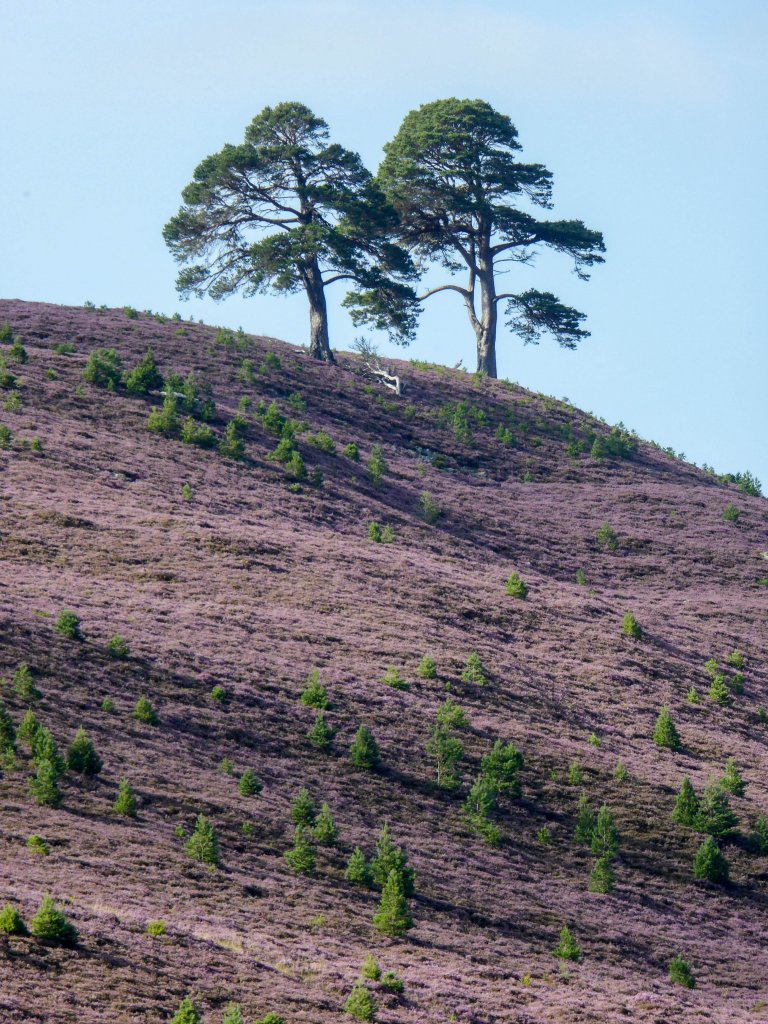
Bagging Munros in winter is a specialist pursuit. Winter in the Scottish Highlands is a majestic spectacle, where the landscape transforms into a pristine wonderland blanketed in snow. For adventurers seeking a thrilling challenge, bagging Munros in winter offers an unparalleled experience.
Bagging Munros takes on a whole new level of excitement in the winter months. The landscape undergoes a metamorphosis, as the summits are cloaked in snow and ice. Each ascent becomes a test of skill, endurance, and determination, as trekkers navigate through snowdrifts, icy slopes, and unpredictable weather conditions.
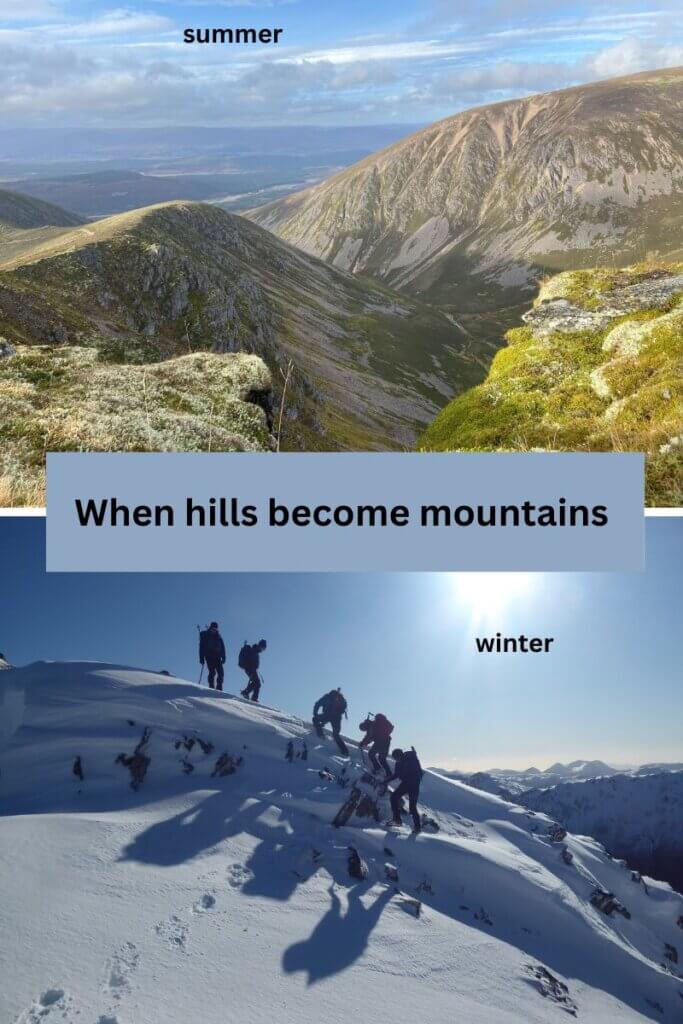
It’s difficult for those from areas where the mountains are 1000s of meters high to appreciate the challenge which Scotland can offer in winter. Every year people die in our winter. The power of nature in a maritime climate should not be underestimated. Winds can regularly be hurricane force; which is challenging in itself. Add to that a high level of precipitation; whiteout conditions and you have the equivalent of mountains in the Alps about 3000m high.

Test your limits, within your means
Preparation is paramount when embarking on a winter Munro bagging expedition. Proper gear, including crampons, ice axes, and layered clothing, is essential to combat the harsh elements and ensure safety. Additionally, knowledge of avalanche awareness and navigation skills are indispensable for navigating the treacherous terrain.
One of the most exhilarating aspects of bagging Munros in winter is the unparalleled sense of accomplishment that comes with conquering these peaks amidst the challenging conditions. The crisp mountain air, the breathtaking vistas, and the solitude of the wilderness combine to create an unforgettable experience that leaves a lasting imprint on the soul.
However, winter Munro bagging is not without its risks. The unpredictable weather can change rapidly, turning a seemingly benign ascent into a perilous endeavor. It is crucial for adventurers to exercise caution, monitor weather forecasts diligently, and be prepared to alter plans if conditions deteriorate. Make sure you have the relevant skills for the conditions. There are plenty of companies (including ourselves) who can offer both navigation and winter skills training. If you are just thinking about beginnning winter walking, this is a good place to start.
Despite the inherent challenges, the rewards of winter Munro bagging are immeasurable. Each summit conquered represents a triumph of the human spirit over adversity, a testament to the indomitable will of the adventurous soul. Moreover, the camaraderie forged among fellow mountaineers in the face of adversity fosters a sense of community and shared purpose that is truly special.
In conclusion, bagging Munros in winter is a pursuit that embodies the spirit of adventure and exploration. It offers a unique opportunity to experience the untamed beauty of the Scottish Highlands in its most raw and awe-inspiring form. For those who dare to venture into the frosty embrace of the mountains, the rewards are boundless, promising memories that will be cherished for a lifetime. So, grab your gear, heed the call of the wild, and embark on an unforgettable journey to conquer the Munros in winter.
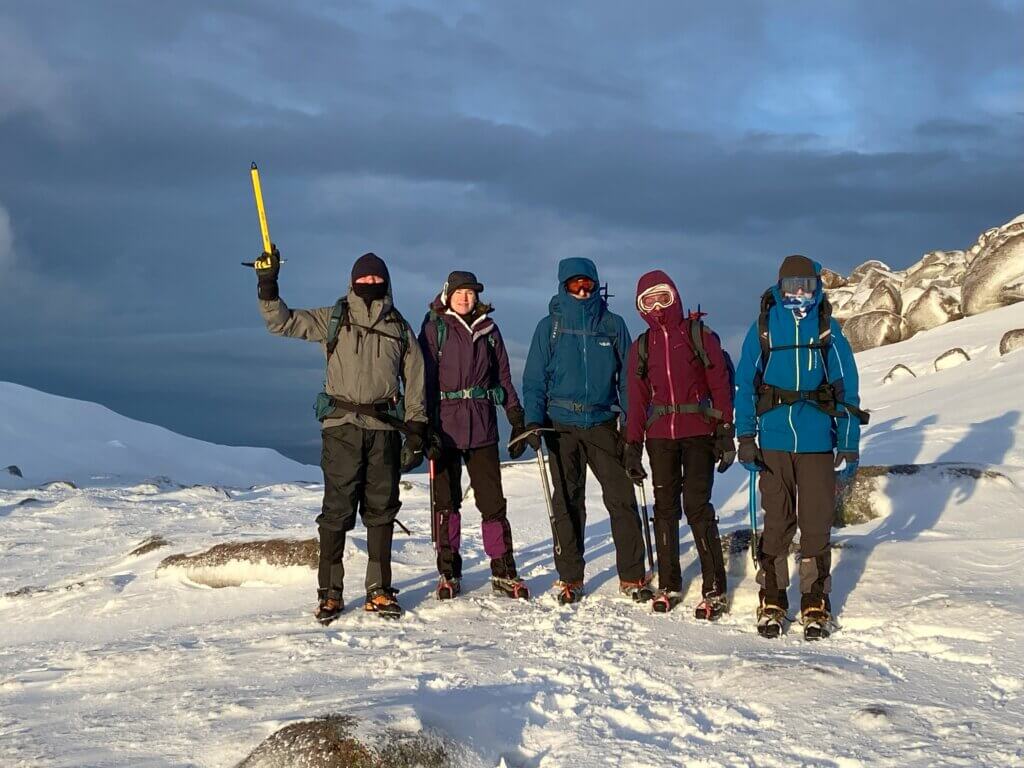
Walking comes in many different guises from dog walking to marathon walking. Perhaps then there’s a reason why “hiking” is becoming much more common usage for wild walking, long-distance and mountain walking. Hiking in summer and walking in winter can almost be classed as 2 different sports.
You might be a keen walker. Alternatively you might have started to develop an interest in walking later in life. You might be walking for health reasons or you might be Munro bagging. Whatever the reason, once you turn to hiking in the mountains, sooner or later you might want to extend your season so you can continue to hike all year round. You’ll want to go walking in winter.
Hiking in winter has its own distinct rewards from unending views in crystal, clear air conditions to solitude and glistening fresh snow, unblemished by evidence of other people. There are however also obvious hazards and also some aspects to winter walking/hiking, which you might not have considered.
In Scotland the winter mountains will almost invariably have snow on them for at least part of the winter. We live in hope that the season will be longer and the snow will remain, but this year, 2017, even the most stubborn of snow patches melted away completely. It’s nearly the end of October already and there’s as yet no sign of the white stuff returning. Still if you are considering some winter hiking, make sure you have received some formal training in the skills you need to remain safe in winter conditions. There is nothing more sapping than cold weather.
There are a surprising number of avalanches in Scotland but most of them go un-witnessed and hence unreported. Fortunately we do have a very good avalanche information service, especially in the Cairngorms. Throughout the winter they produce a daily report of the avalanche risk. With formal training and a bit of experience, you can learn to interpret the report so that you pick the safest route for the day.
Making sure you have the proper boots for winter is essential. “Your boot is as much as tool as your crampons and ice axe” is a sentence often repeated by our own Andy Bateman when he is talking to winter novices. You must have stiff boots rated as B2 or above. However, the problem with the boots is that they weigh a lot more than boots you will be used to walking in and they are so much stiffer that they force you to walk in a slightly different gait from usual. Over the course of a couple of days, the difference in the boots can take its toll on you. You legs and feet will feel a lot more tired than they usually do for the same amount of summer walking.
Take care when wearing winter boots. Try to baby your feet a wee bit and if you have the opportunity a little bit of simulation will stand you in good stead, even if people give you funny looks when you clump along the beach promenade or up and down the city streets in monster boots.
Your pack, whether for an expedition or a day walk, is inevitably going to be bigger in winter. Not only will you need more in your lunch, but you’ll also need space for the additional gear: your ice axe, your crampons, thicker, warmer gloves etc. You’ll need to be ready for the extra weight.
TOP TIP: always try to pack your crampons within your pack as if you have them tied to the outside of your pack, you run the risk of losing one or both of them quite easily.
In winter Scotland’s hills become mountains due to the severity of the weather conditions. There are regularly winds over 100 miles an hour in storms and though you might not plan to be out in conditions like that, even experienced mountaineers can get caught out. A friend of ours was once out in the Cairngorms when the weather turned. He and his party ended up almost crawling out as they were getting blown over when they stood up. The wind was even strong enough to take a head torch off one of their heads.
It’s not only the colder weather which helps to burn up more calories. You do have to carry more stuff with you when you go out hiking in winter. The additional weight will help to burn more calories at the end of the day. But always remember, if you put more calories in than you consume you won’t be losing weight. Just heading out for a hike is not a guarantee that you will lose weight – if that is your aim. You need to balance out keeping warm with the number of calories you consume. You don’t want to be cold, but neither do you want to overeat.
How many calories are burned by being cold?
Calories burned in cold weather
Cold air carries less moisture than warm air and therefore produces better visibility. It is warm air streams which bring precipitation. There is some truth to the statement that it is too cold in the arctic to snow.
Fewer people enjoy going out in the cold weather despite the fact that we have amazing gear now which can keep us warm in virtually any conditions. However, this means that those of us who do go out can enjoy a real sense of solitude and space.
There’s nothing better than sharing the story of the day. The warmth of a fire and a cup of tea at the end of the day will be appreciated so much more after being out in cold conditions.
When people come back after a day out in the snow, they almost always have a novel story to share. The risks are greater than in the summer, but then this enhances the benefits too.
If you stop going out in the colder weather, it may be more difficult to get back to your regular hiking than before. The risk of losing your fitness over the winter is greater as you get older. Walking on the treadmill isn’t really an adequate substitute, but if there’s no other choice …
I don’t know why the mountains seem so much more spectacular when covered in snow, but they do. Maybe it’s because they look more pristine. Maybe it’s because if gives them more shape. Whatever the reason, a little snow seems to add some “je ne sais quoi” to the mountain scene.
We specialise in guided walking holidays and walking skills here in Scotland.
If you’d like to leap in to winter at the deep end, why not think about a snow hole expedition: not an igloo, a snow hole; not an emergency shelter but a deliberate night out in a purpose built shelter. Check it out:
We’ve scheduled a new trip for winter 2024. We’re going to be based in Glencoe for a week in March bagging some tasty Munros. It’s a new venture for us so we’ve looked for some spectacular images to illustrate the trip. On a search of Flickr, we found John McSporran. John has kindly agreed not only to lend us some of his spectacular Glencoe images, but he’s also written a brief summary of why he personally finds Glencoe such a fascinating area to explore.
I first began photographing Glencoe about 20 years ago. It is one of those places where the weather is always changing, the light can be fantastic one minute and terrible the next. It can be mean and moody, mystical and magical, but always interesting and frequently awe inspiring. Even on horrible days, that fleeting moment when a beam of light strikes the mountains makes it all worth while.
About 10 years ago I realized that if I wanted the best photos of Glencoe I needed to get high. That’s when I began climbing its mountains. Then I realized that I needed to be ‘up top’ for sunrise and sunset (the golden hours). That’s when I climbed in the dark using a head torch. Then I began to camp out up top. Then I went ‘full on’ and climbed in the dark in mid winter using an ice axe and crampons – just for that one great photograph. Carrying 25 kilos / 55 lbs of camping and photography gear to the top of a mountain can be hard (particularly when in your late 50’s), but the experience of stunning sunrises and sunsets in Glencoe makes it all worth while.
I have met hundreds of people on the Scottish mountains, some I meet many times, some only once, but there is a community spirit amongst those who climb mountains, especially photographers – solitary committed people whose hard shell cracks as soon as we begin to swap stories.
My favourite Glencoe mountains are Beinn a’Chrulaiste and Buachaille Etive Beag. They are not the hardest or the tallest, but they provide the best viewpoints and give sweeping panoramas of the others.
Other favourite locations are:
There are so many great locations, you are spoiled for choice.
We have a saying in Scotland – if you don’t like the weather, wait 15 minutes, it will change. I hope you enjoy your visit to Glencoe.
For more choices of walking holidays in Scotland, head over to our main holiday page
For more information on walking in the Highlands
Winter has descended upon the Scottish Highlands, the familiar hills evolve into awe-inspiring mountains, blanketed in a pristine coat of snow, setting the stage for a winter hiking experience like no other. The landscape, now a picturesque haven, invites adventurers to traverse its snow-laden trails, discovering a unique blend of tranquility and adventure. However, one must always keep an eye on the ever present dangers inherent in winter.
Winter hiking in the Highlands offers a striking contrast to other seasons. The once-green paths are now transformed into a pristine canvas of white, waiting to be explored. Intrepid hikers, armed with waterproof gear and insulated boots, embark on journeys that unveil the Highlands’ winter charm.
Traversing the snow-covered trails is a sensory delight. The crunch of snow beneath each step echoes through the valleys, and the brisk winter air invigorates the senses. The hills, now adorned with a glistening layer of frost, create a visual spectacle that adds an extra layer of magic to the hiking experience.
Never forget though that you need to be extra prepared before you head out into the winter hills. Our top tips include:
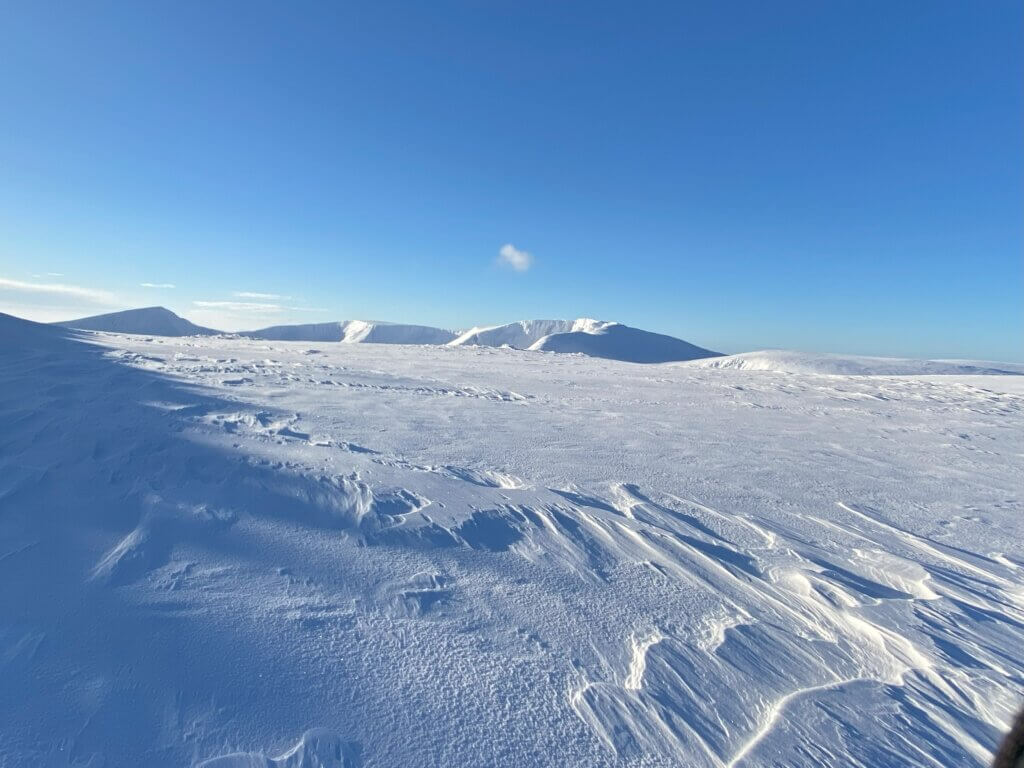
Cairngorm plateau, New Year Winter Walking 2022 – 2023
Preparation is key for those eager to embrace the winter landscape. Layered clothing, including waterproof jackets and insulated gloves, become essential companions (see our blog). As the landscape transitions from hills to mountains, the weather can be unpredictable, and hikers must be equipped to face the challenges that come with the season.
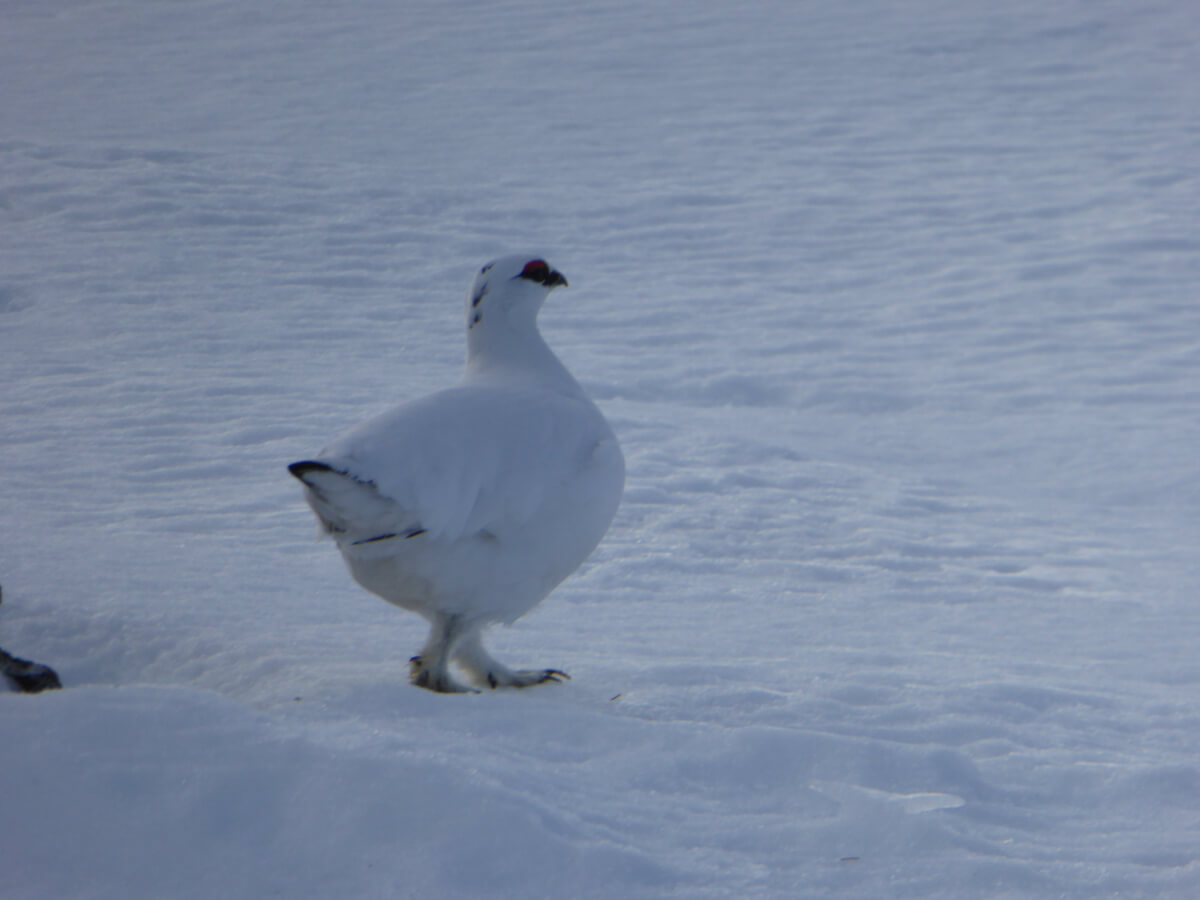
A ptarmigan makes walking across the snow look easy
Popular winter hiking routes in the Highlands include the West Highland Way, the Great Glen Way and the Speyside Way; which transform into a winter wonderland, offering panoramic views of snow-capped peaks and frozen lochs. The Cairngorms National Park, with its diverse trails, provides opportunities to witness the Highland wildlife amidst the winter spectacle; and for the intrepid this area can become a wilderness for the most intrepid to explore and indulge in winter sports and adventures like snow holing.
Hiking in the Highlands during winter is not just a physical adventure but also a journey into solitude and reflection. The silent majesty of the snow-covered landscape imparts a sense of serenity, inviting hikers to connect with nature on a deeper level.
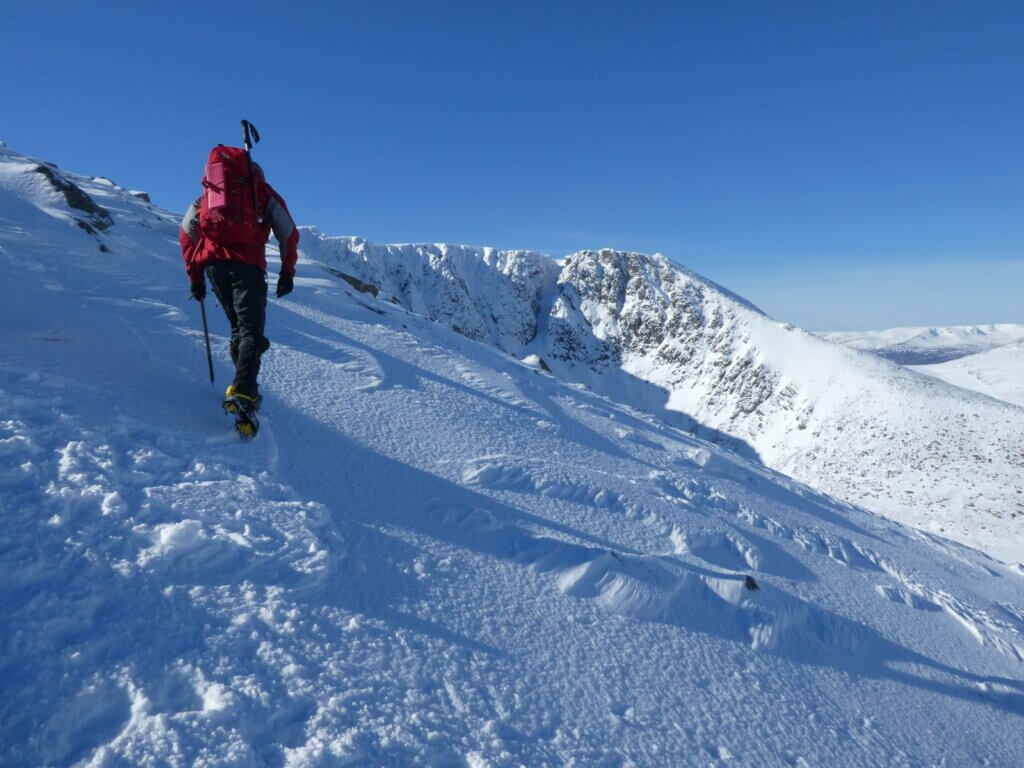
Cozy hostels nestled along the trails and in the villages close by offer refuge after a day of winter exploration. Hostels provide a welcoming retreat where hikers can share stories and relish in the hearty warmth of local hospitality.
Winter hiking in the Highlands of Scotland is a testament to the enduring spirit of nature. It is an invitation to witness the marriage of untamed beauty and the thrill of adventure. So, lace up your boots, embrace the chill, and discover the enchanting transformation that occurs when the hills become mountains in the heart of a Highland winter.
Check out our range of guided winter walking holidays
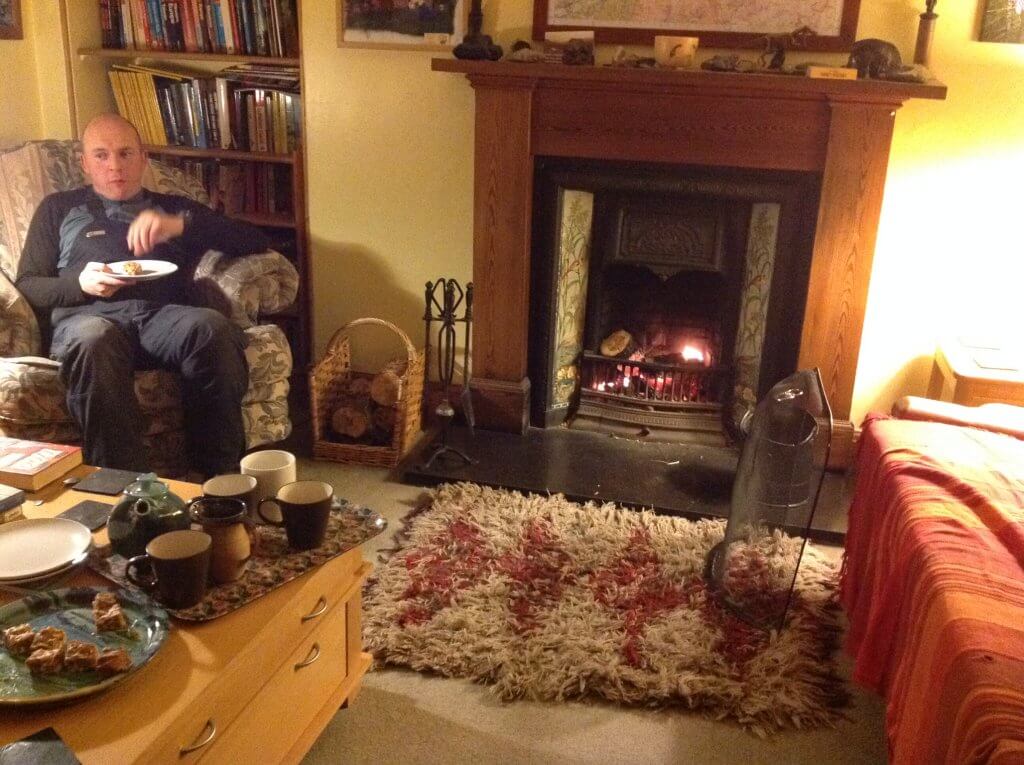
Everyone loves an open fire, almost as much entertainment as the TV
Have you ever wondered what all the fuss is about? Scotland. Why? Especially in winter must be far too cold and far too dangerous. Take a look – yes, it’s proper winter but isn’t that preferable to wet rain, umbrellas and grey days with little to differentiate between summer and winter, except for the lack of leaves on the trees.
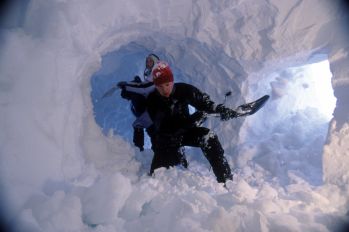
Photo Credit: Paul Tomkins/VisitScotland
Digging out a snow hole site in the Cairngorms under the guidance of Andy Bateman of Scot Mountain Holidays. It’s not quite Sweden’s ice hotel as you have to create the living space yourself, but they’ll have a relatively comfortable night out of the wind, cocooned in their sleeping bags enjoying being cooked for and served a three course meal by their guide.

Build your own snow hole in the Cairngorms
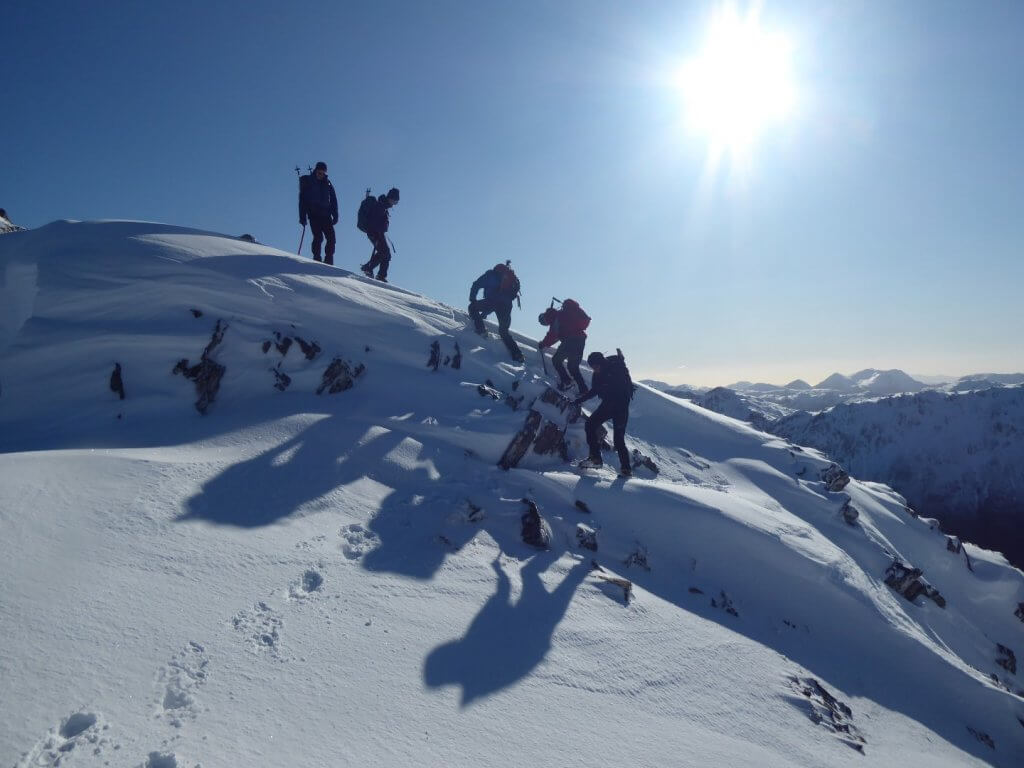
Hiking along the ridges of Argyll, Kintail or Glencoe – space to yourself away from all the crowds and views which stretch for miles under clear skies. We often visit the west coast of Scotland in March to bag some winter Munros: we’ve run trips in Argyll, Glencoe and Kintail. For this year’s offering check the calendar or the Munro bagging page. Some of our clients have left from these trips with the most spectacular images – but those are for another blog.
Photo credit: Dave Downing
The beauty of Glenmore in the winter. Snow laden trees and cross-country skiing opportunities. Short days are not always a disadvantage as they allow for the most spectacular photographic opportunities, as seen above.

Safety skills for walking in the winter hills, demonstrated here by Andy Bateman – ice axe arrest. Legitimate playing in the snow, but as part of a learning process on how to avoid a sliding fall.
Scotland on a cold, clear, crisp day in winter. What’s not to like, especially if you like to take stunning pictures.
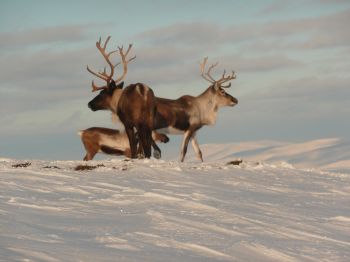
The Cairngorm Reindeer herd in their natural environment. When out walking in the Park, you can come face to face with the reindeer who roam the hills in winter.
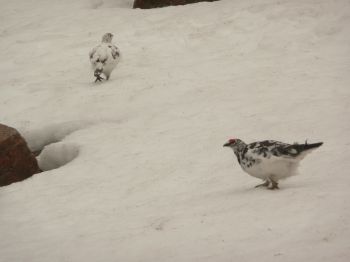
The Scottish Munros, particularly the Cairngorms, are the only area of the UK where you can spot Ptarmigan. Ptarmigan change their plummage twice a year – they have a summer coat, a breeding plummage and a winter coloration to blend in with the snow. You can almost step on the Ptarmigan sometimes as they like to conserve their energy by walking rather than flying if they can and they nest on the ground – there being no trees at the elevation where they are found.
a chance to savour some of Scotland’s most famous and unique produce. Haggis is a traditional meal to celebrate Scotland’s greatest bard, whose influence can be found everywhere from the Birks of Aberfeldy (where there is a thinking/writing seat dedicated to Rabbie Burns) to the Winking Owl in Aviemore, where the great bard is said to have taken breakfast. You might not even be aware of his influence on your own life from: “And we’ll tak a cup o’ kindness yet, for auld lang syne” – which you’ll have sung if you’ve ever brought the New Year in; to “O’ my luve’s like a red, red rose, that’s newly sprung in June” and a special Scottish grace for a meal: “Soem hae meat and canna eat And some would eat that want it. But we hae meat and we can eat, sae let the Lord be thankit.”
Burns Night is 25th January and is celebrated throughout Scotland with a haggis meal and the address to the haggis – written by Rabbie Burns.
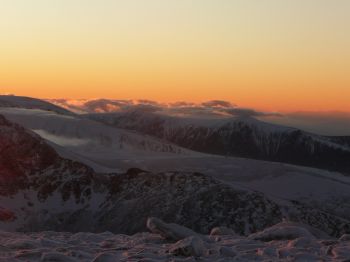
Scotland is famous for the colours of heather in the summer but the winter can be colourful too. This is the time of year that you’ll get to appreciate the sunset. The snow also reflects the light of the moon & stars if the sky is clear, so a night out in winter can be glorious.
snow will entertain the kids for hours and cost nothing, but make sure you’re well stocked with socks, gloves and hot chocolate!
Useful links:
Snow related activities for kids:
Free mountain weather service:
Met Office forecast for the hills:
Scottish Avalanche Information service:
You’ve probably heard that the Funicular Railway on Cairngorm Mountain is closed for now and will probably remain closed for some time to come as there has been no hint of when it will be up and running again. Not to worry though, there are ways around it.
Really it shouldn’t impact on your stay in the Cairngorms at all, but you might need to postpone your plans for a wedding at the Ptarmigan restaurant.
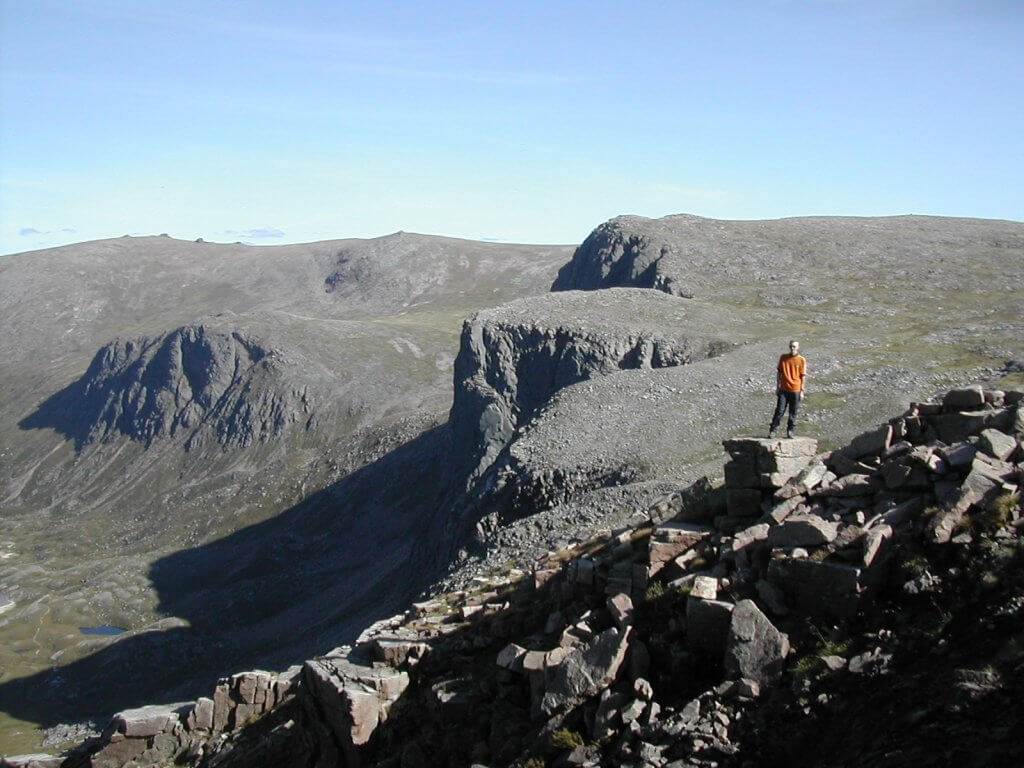
Deep in the Cairngorms National park. What a view!
Cairngorm Mountain are still running a ski season. Season passes and tickets have been reduced as access to the slopes is more limited without the funicular uplift. Skiers need to be prepared for an 8 minute walk to the tow bars. For beginners there has been snow machine snow and magic carpets from the official start of the season in December.
Of course, the funicular is not necessary and never has been to access all the winter activities you could participate in. All winter walking and winter skills courses are running as normal and it is even approaching time for snow hole expeditions after the recent snow days.
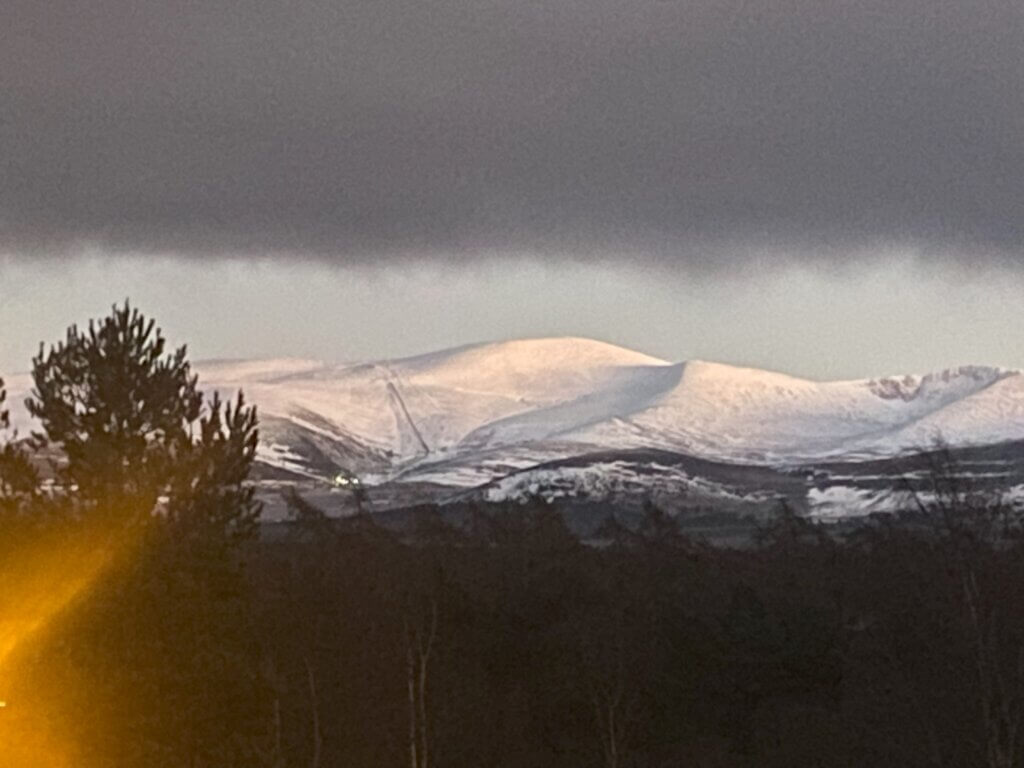
The funicular is just a train. It has allowed people to get up near the top of Cairngorm i.e. to the Ptarmigan restaurant. However, there has always been a visitor management plan in place. The plan means that if you use the train to go up on the mountain, then you are restricted to the Ptarmigan centre at the top. You are not permitted to get out and explore the greater mountain area. The only way of accessing the mountain at all was to book a guided walk to the top.
This summer these options potantially won’t be open to you – but you can plan around ahead for that possibility. Here are some possible alternatives:
There are still many reasons to go to Cairngorm when you’re in the area. Just because there’s no train or restaurant at the top, doesn’t mean that there aren’t still compelling reasons to include it in your list of things to do.

A family day out on the summit of Cairngorm (with diversions to hunt for snow)
We look forward to seeing you out in the Cairngorms. Remember not having the train up is not necessarily a bad thing. Making your own way to the top will give you a far greater sense of achievement and well-being.
All content © Copyright Scot Mountain Holidays 2025
Responsive web design by Summit Web Solutions